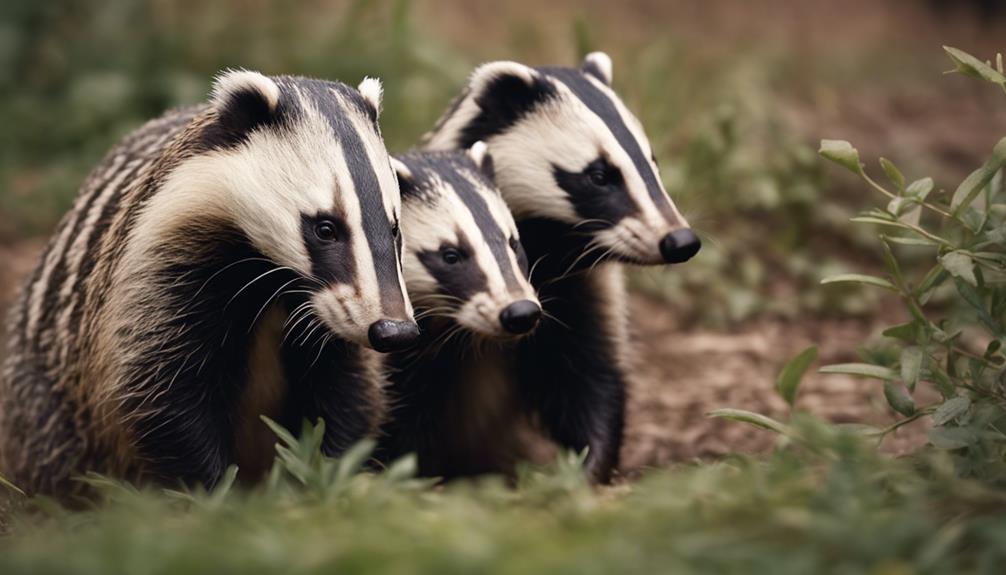As you ponder the intriguing world of badgers, you may find yourself wondering about the differences between the American badger and its UK counterpart. These two species, although sharing some similarities, boast unique characteristics that set them apart.
From their physical attributes to their hunting strategies, exploring the distinctions between these badgers promises a fascinating journey into the realm of wildlife diversity.
Physical Characteristics

When comparing the physical characteristics of the American badger to the European badger, notable differences in size and appearance become apparent.
The American badger is smaller, weighing between 14-33 lbs and measuring 20-30 inches long, whereas the European badger is larger, weighing 15-37 lbs and measuring 24-35 inches long. American badgers have a stocky body with distinctive head markings and long fore claws, giving them a rugged appearance. In contrast, European badgers sport a salt and pepper grey coat with a larger white stripe on their head, which sets them apart in terms of visual aesthetics.
These differences in size and appearance between the American and European badgers play a significant role in distinguishing the two species.
The American badger’s compact build and unique head markings reflect its adaptation to the grassland habitats it prefers. On the other hand, the European badger’s larger size and distinct coloration suit its wooded environment and underground tunnel lifestyle.
Habitat Differences

In considering the habitat differences between American badgers and European badgers, it becomes evident that their preferred environments significantly shape their behavior and lifestyle.
The American badger favors open grasslands, providing ample space for foraging and hunting, while the European badger thrives in wooded areas with well-drained soil, offering cover and suitable conditions for digging their elaborate setts. American badgers have a larger range of 100-1000 hectares, allowing them to roam more extensively compared to European badgers, whose range typically spans 20-50 hectares.
European badgers construct intricate underground tunnel systems known as setts, where they live in social groups, whereas American badgers tend to be more solitary in their habits. Additionally, European badgers may hibernate in Northern Europe, a behavior not commonly observed in American badgers.
These habitat distinctions profoundly influence the social behavior, range size, and preferred living conditions of the American and European badgers.
Behavior Contrasts
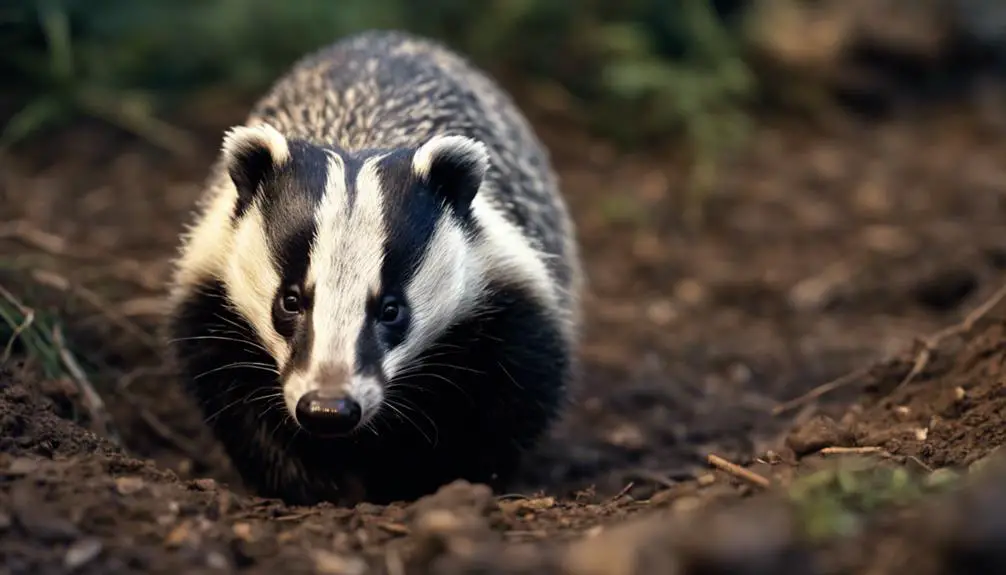
Contrasting the behavior patterns between American badgers and European badgers reveals striking differences in hunting strategies and social structures. American badgers are known for their solitary hunting habits, often preying on small mammals, insects, and squirrels alone. On the other hand, European badgers live in social family groups called clans, exhibiting a more cooperative approach to hunting and sharing an omnivorous diet that includes cereals, fruits, and insects.
European badgers tend to prefer wooded areas as their habitat, while American badgers favor open grasslands for foraging. Additionally, European badgers exhibit a behavior not commonly seen in American badgers – hibernation, especially in Northern Europe where the winters are harsh. Moreover, American badgers have a larger range of 100-1000 hectares compared to European badgers, whose range typically falls between 20-50 hectares. These behavioral variances play a significant role in shaping the distinct lifestyles of American and European badgers.
Diet Variances
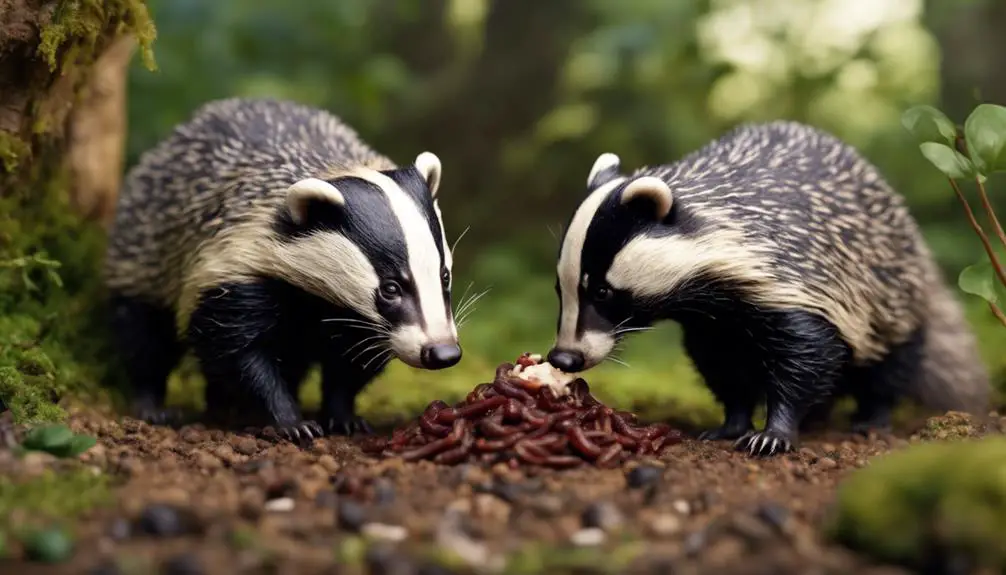
American badgers primarily focus on hunting small animals, while European badgers have a more diverse diet that includes plant matter. This diet variance is closely linked to their habitat preferences, with American badgers favoring grasslands where small animals are abundant and European badgers preferring wooded areas with access to plants and insects.
| Diet Variances | American Badgers | European Badgers |
|---|---|---|
| Primary Food | Small animals such as | Varied diet including |
| squirrels, moles, and | cereals, fruits, insects, | |
| insects. | and small mammals. |
The habitat plays a crucial role in shaping the dietary habits of these badger species. American badgers have adapted to grasslands where they can efficiently hunt small prey, while European badgers take advantage of the resources available in wooded areas, showcasing their omnivorous nature. These diet variances highlight the remarkable ability of badgers to thrive in different environments by utilizing a wide range of food sources.
Reproduction Varied
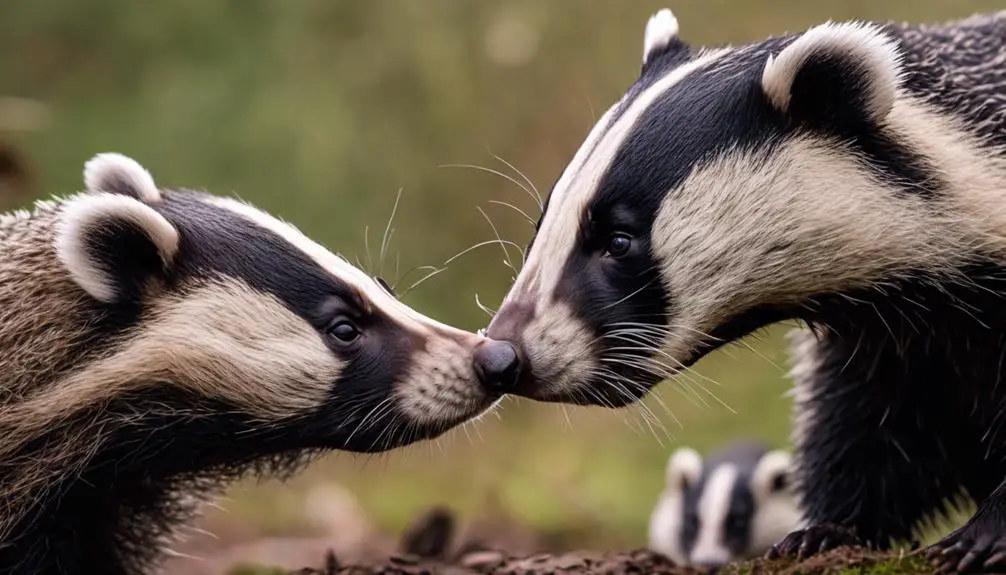
Shifting focus to the reproductive behaviors of these badger species, you’ll find notable differences in breeding seasons and litter sizes between American and European badgers. American badgers typically breed in late summer, while European badgers mate in spring.
When it comes to litter sizes, female American badgers give birth to 1-5 cubs after a gestation period of 6 weeks, whereas European badgers usually have 2-3 cubs. American badger cubs are born blind and helpless, opening their eyes around 4 weeks old, unlike European badger cubs that are born with their eyes open and more developed.
The weaning period for American badger cubs is about 2-3 months, while European badger cubs are weaned by 3-4 months. In terms of maturity, American badgers reach sexual maturity at around 9-12 months, slightly earlier than European badgers, which reach maturity at 10-12 months. These differences in reproductive patterns contribute to the unique characteristics of American and European badger populations.
Predation Threats

Badgers in both the US and UK face significant predation threats from a variety of natural predators. Predators such as cougars, golden eagles, bobcats, bears, coyotes, grey wolves, lynx, and brown bears pose risks to the badger populations in both regions. In the UK, European badgers are particularly vulnerable in high population density areas and are also at risk from accidents on busy country roads.
To provide a clearer overview, let’s delve into the table below showcasing the predation threats faced by badgers in the US and UK:
| Predator | Predation Threat |
|---|---|
| Cougars | Significant threat to badgers in the US |
| Golden Eagles | Pose risks to badgers in both regions |
| Bobcats | Predation threat to badgers in the US |
| Coyotes | Impact badger populations in the US and UK |
| Bears | Threat to badgers in both the US and UK |
| Grey Wolves | Predation risks for badgers in the US |
| Lynx | Impact badgers in the UK |
| Brown Bears | Significant threat to badgers in the US and UK |
These predation risks contribute to the evolution of badgers’ survival strategies in both the US and UK, shaping their population dynamics and behaviors. Conservation efforts take into account these predation threats to ensure the stability and well-being of badger populations in both regions.
Conservation Efforts
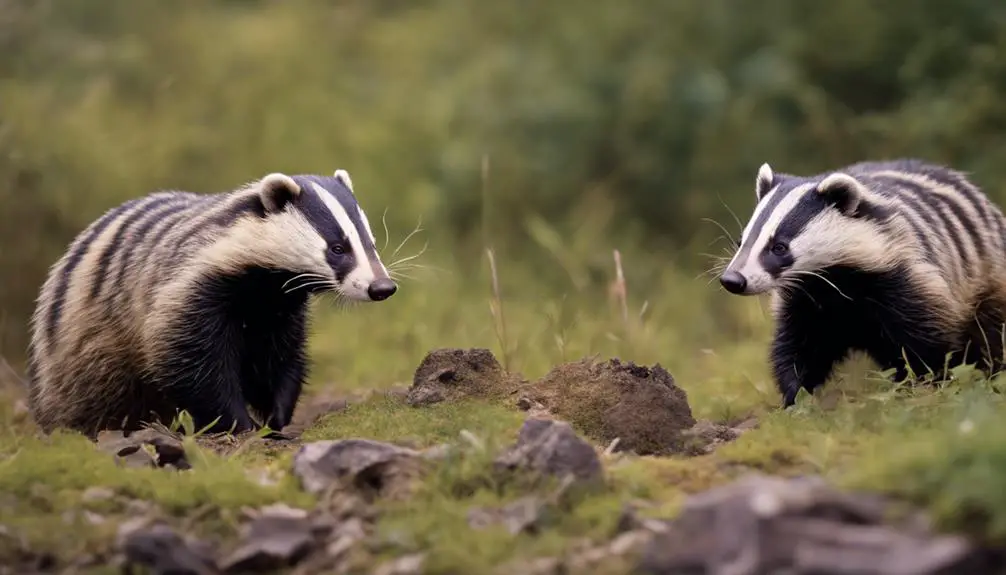
Facing significant predation threats, conservation efforts for badgers in the US and UK are crucial to ensure their survival and well-being. In the UK, specific laws such as the Protection of Badgers Act 1992 provide essential support for badger conservation.
However, badger culling remains a contentious issue in the UK, especially concerning disease control like bovine tuberculosis. Research on UK badgers concentrates on population dynamics, behavior, ecology, and interactions with other species to develop effective conservation strategies.
European badger conservation efforts extend to exploring the benefits of agri-environment schemes for hedgehogs and analyzing dietary adaptations due to changes in prey availability. The conservation of UK badgers relies on a combination of legal protection, ongoing research initiatives, and practical conservation measures.
Population Variances
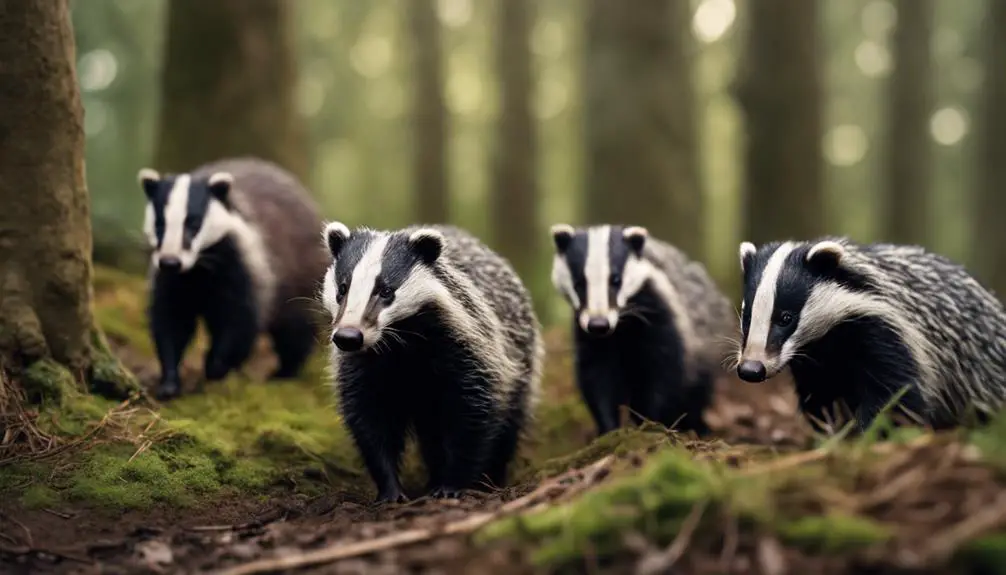
In comparing the populations of American and European badgers, you’ll find interesting variances.
American badgers total around 200,000 individuals, while their European counterparts range from 250,000 to 400,000.
Additionally, their habitat distributions differ, with American badgers scattered across the Great Plains and western US, and European badgers concentrated in woodlands and rural landscapes.
Population Sizes Comparison
Comparing the population sizes of American and European badgers reveals notable variances in their respective numbers. American badgers in the United States have a population ranging from 200,000 to 500,000 individuals, whereas European badgers, found in the UK and other parts of Europe, number around 250,000 to 300,000 individuals.
The population density of American badgers is affected by habitat fragmentation and human development, while European badgers face challenges such as habitat loss, road collisions, and culling practices. Conservation efforts for both species aim to maintain stable population sizes and address threats to their survival.
Despite these differences, efforts are being made to ensure the long-term viability of both American and European badger populations.
Habitat Distribution Differences
American badgers primarily inhabit the Great Plains regions of the United States, while European badgers, also known as Eurasian badgers, are commonly found across Europe, including Russia and Scandinavia.
European badgers prefer wooded areas with well-drained soil, living in setts with other families, whereas American badgers favor open grasslands and exhibit more solitary behavior.
The habitat range of American badgers can vary from 100 to 1000 hectares, whereas European badgers typically occupy 20 to 50 hectares. European badgers in Northern Europe may hibernate, facing threats in high-density areas and from busy country roads, impacting their habitat distribution.
Despite these differences, both American and European badgers are classified as species of Least Concern on the IUCN Red List, indicating stable populations.
Cultural Significance

Badgers in the UK have a rich history intertwined with folklore and tradition, making them a symbol of courage and protection. The cultural significance of badgers is evident in their portrayal in various forms of media and their representation of the British countryside.
Conservation efforts, like the Protection of Badgers Act 1992, highlight the importance of preserving these beloved creatures in British culture.
Folklore and Mythology
In European folklore, badgers have long been revered as wise and cunning creatures, embodying traits of protection, healing, and courage in various myths and legends. In UK folklore, badgers are associated with these qualities and often symbolize strength and perseverance.
Stories featuring badgers, like Mr. Badger in ‘The Wind in the Willows’ by Kenneth Grahame, highlight their significance in literature. European badgers play a role in indigenous beliefs and superstitions, representing determination and resilience across different cultures.
Their presence extends beyond stories, inspiring artistic expressions in various forms such as art, music, and as mascots for sports teams and organizations. Badgers continue to hold a special place in folklore and mythology, showcasing their enduring cultural importance.
Conservation Efforts
Amidst the rich tapestry of folklore and mythology surrounding badgers in the UK, their conservation efforts stand as a testament to their enduring cultural significance.
The Protection of Badgers Act 1992 plays a crucial role in safeguarding these iconic creatures from harm and interference. While badger culling has sparked debates to address diseases like bovine tuberculosis, the UK balances conservation with public health concerns.
Celebrated in British folklore, literature, and traditions, badgers hold a special place in the hearts of the people. Ongoing research studies delve into badgers’ population dynamics, ecology, behavior, and interactions with other species, aiming to inform effective conservation strategies.
The commitment to protecting badgers reflects the deep-rooted cultural importance attached to these beloved animals.
Future Outlook
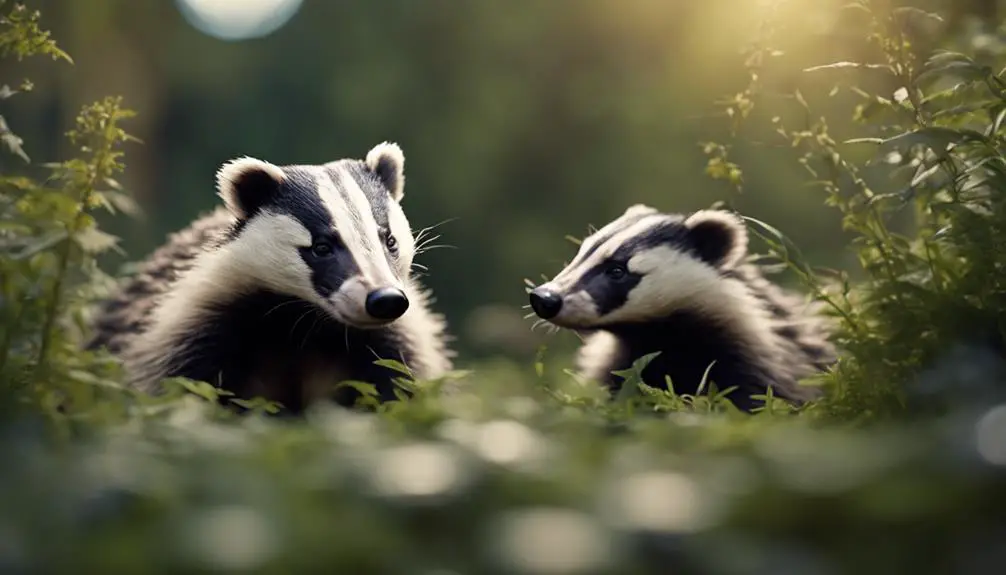
Conservation efforts for US and UK badgers are pivoting towards proactive measures to safeguard habitats and minimize human-wildlife conflicts. Both American and European badgers face challenges that have led to their classification on the Red List, highlighting the importance of conservation efforts. Research on badger behavior and population dynamics in the US and UK is crucial for developing effective strategies to ensure their future survival.
Moving forward, monitoring population trends, addressing habitat fragmentation, and promoting coexistence with human activities are key aspects of the future outlook for badgers in both regions. Additionally, the impacts of climate change on badger habitats are a growing concern, prompting the need for studies on adaptation strategies to mitigate these effects.
Collaborative efforts between researchers, conservationists, and policymakers will be essential in shaping the future of US and UK badger populations. By working together and implementing proactive conservation measures, we can strive to secure the long-term well-being of these iconic mammalian species.
Frequently Asked Questions
Are European Badgers Related to American Badgers?
Yes, European badgers and American badgers are related as both belong to the same family, Mustelidae, under the order Carnivora. Despite being distinct species, they share common ancestry and evolutionary traits that shape their characteristics.
Are British Badgers Aggressive?
British badgers are typically non-aggressive towards humans, avoiding conflict if possible. However, they may display defensive behavior when feeling threatened or protecting their territory. Understanding and respecting their space can help prevent conflicts.
Are American Badgers Aggressive?
American badgers can be aggressive when threatened, using claws and jaws for defense. They are solitary and defend territory fiercely. Despite this, there are no records of unprovoked attacks on humans. Give space and avoid confrontations.
What Is the American Version of a Badger?
The American version of a badger is Taxidea taxus, a carnivorous mammal with stocky body, distinctive head markings, and long fore claws. They prefer open grasslands, are solitary, and primarily prey on squirrels, moles, and insects.

Erzsebet Frey (Eli Frey) is an ecologist and online entrepreneur with a Master of Science in Ecology from the University of Belgrade. Originally from Serbia, she has lived in Sri Lanka since 2017. Eli has worked internationally in countries like Oman, Brazil, Germany, and Sri Lanka. In 2018, she expanded into SEO and blogging, completing courses from UC Davis and Edinburgh. Eli has founded multiple websites focused on biology, ecology, environmental science, sustainable and simple living, and outdoor activities. She enjoys creating nature and simple living videos on YouTube and participates in speleology, diving, and hiking.
🌿 Explore the Wild Side!
Discover eBooks, guides, templates and stylish wildlife-themed T-shirts, notebooks, scrunchies, bandanas, and tote bags. Perfect for nature lovers and wildlife enthusiasts!
Visit My Shop →
